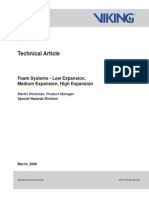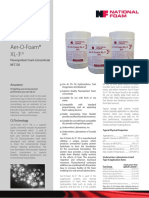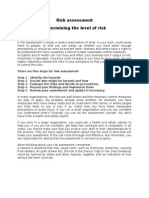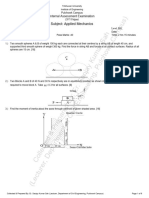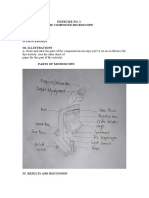Chapter 5
Chapter 5
Uploaded by
poojaupesCopyright:
Available Formats
Chapter 5
Chapter 5
Uploaded by
poojaupesOriginal Description:
Original Title
Copyright
Available Formats
Share this document
Did you find this document useful?
Is this content inappropriate?
Copyright:
Available Formats
Chapter 5
Chapter 5
Uploaded by
poojaupesCopyright:
Available Formats
Fire fighting using foam
Introduction
A fire fighting foam is simply a stable mass of small air-filled bubbles,
which have a lower density than oil, gasoline or water. Foam is made up of
three ingredients- water, foam concentrate and air. When mixed in the
correct proportions, these three ingredients form a homogeneous foam
blanket.
Fire fighting foam are widely
used to control and extinguish
fires involving flammable liquid.
When applied in correct manner
and in sufficient quantity, foam
forms a stable blanket that floats
on the surface of the flammable
liquid.
How they work
Foam extinguishes flammable or combustible liquid fires in four ways-
Excludes air from the flammable vapour.
Eliminates vapour release from fuel surface.
Separates the flames from the fuel surface.
Cools the fuel surface and surrounding metal surfaces.
Type of foam- 1.Chemical foam
2.Mechanical foam (based on expansion ratio)
i) low expansion foam
ii) medium expansion foam
iii) high expansion foam
low expansion foam are most commonly used in our terminals.
Cont..
Foam concentration are the most commonly used by fire fighters-
Protein foam concentration
Fluoroprotein foam concentration
Film forming fluoroprotein foam concentration(FFF PF)
Aqueous film forming foam
concentration(AFFF)
Alcohol resistant foam
concentration(AR-AFFF)
Synthetic detergent foam
(mid & high expansion)
Protein foam- regular protein foam(RP) are intended for use on
hydrocarbon fuels only.
They produce a homogeneous , stable foam blanket that has
excellent heat resistance , burn-back ,drainage and slow knockdown
characteristic.
RPF may be used with fresh or sea water.
Aqueous film forming foam(AFFF)- Deigned to provide the
fastest possible knockdown on hydrocarbon fuels .Their fluidity
allows them to quickly flow around obstacles.
Standard AFFFs are premixable, can be used with either fresh or sea
water.
It is the combination of fluorochemical surfactant and synthetic
foaming agents . This extinguishing fires by forming an aqueous
film.
This film is thin layer of foam solution that spread rapidly across
the surface causing dramatic fire knockdown.
Alcohol resistant aqueous film forming foam(AR-AFFF)-
Are produced from a combination of synthetic detergents ,
fluorochemicals and polymer.
It is also conventional as AFFF on hydrocarbon fuels.
It is used for handling fires involving methonol,ethanol,etc.
Testing of AFFF
Foam compound stored in tanks or open containers should be tested
once in 3 year as per IS4989- 2006 guidelines. These tests cover PH
,viscosity, sludge content and spreading coefficient.
Foam compounds kept in store in sealed containers need be tested
only once in 10 year.
Foam characteristics- to be effective ,a good foam must contain such
characteristics
Knockdown speed and flow-This is required for a foam blanket to
spread across a fuel surface or around obstacles and achieve complete
extinguishment.
Heat resistance- The foam must be able to resist the destructive
effects of heat radiated from any remaining fire from the liquids
flammable vapour and hot metal.
Fuel resistance- An effective foam minimizes fuel pickup so that
the foam does not become saturated and burn.
Vapour suppression- The vapour tight blanket produced must be
capable of suppressing the flammable vapour and so minimize the
risk.
Alcohol resistance- due to alcohols affinity to water and because a
foam blanket is more then 90% of water, foam blankets that are not
alcohol resistant will be destroyed.
Conveying system
System consists of an adequate water supply, foam concentrate. Suitable
equipment, a proper piping system. Foam makers and discharge devices
deigned to adequately distribute the foam over the hazard. There are three
type of system-
1. fixed foam system- It comprises of fixed piping for water supply at
adequate pressure, foam concentrate tank, suitable proportioning equipment
for drawing foam concentrate and make foam solution ,fixed piping system.
2. Semi-fixed foam system- gets supply of foam through the
mobile foam tender. A fixed piping system connected to the foam
maker cum vapour seal box in case of cone roof tanks and foam
maker and foam pourers in case of floating roof tanks conveys
foam to the surface of tank.
3. mobile system- includes foam
producing unit mounted on wheels
which may be self propelled. These
unit supply foam through monitors
to burning surface.
Foam piping & accessories
A) foam tank- these are tanks above ground ,which will have a
capacity equal to the 30 minutes operations requirement of the
largest tank in the group.it will be usually kept at a higher
elevation in order to get gravity feed of the concentration for the
system.
B)Inline foam inductor- it is used to induct the foam liquid
concentrate into the water stream to supply solution of the liquid
concentrate and water ,to the foam producing equipment.
Inductor are designed primarily for use in the fixed foam
installation to provide a simple and reliable method of
proportioning in constant flow application.
C) foam deflector- this is a deflector plate welded to the inside
shell of the storage tank where the foam pourer is fixed.
It directs the generated foam to hit the shell and gradually spread
the compound over the burning liquid without splashing.
D) foam nozzles- for the most effective and economical use of foam,
foam solution must be properly expanded .standard fog nozzles
generally do not provide optimum expansion and therefore do not
provide for the best , most cost effective application of foam.
Foam fire fighting application techniques
a)Bounce-off technique- when foam
nozzles are used ,particular care
should be taken to apply the foam as
gently as possible , for straight stream
use, the foam should be banked off of
a wall or other obstruction when
available.
b)Bank-in techniques- foam can also be rolled onto
the fuel surface by hitting the ground in front
of the spill , and allowing the foam to pile up
in front of the spill.
C) Rain-down technique- The foam nozzle is
directed almost straight up and the foam stream
is allowed to reach its maximum height and break
into small droplets . This technique can provide
a very fast and effective knockdown.
You might also like
- Question Paper For ScaffoldingDocument11 pagesQuestion Paper For Scaffoldingpoojaupes100% (8)
- TS4065 McCloskeyDocument61 pagesTS4065 McCloskeyOrlando Melipillan100% (2)
- Pilot Operations Handbook C182 (1970-182N)Document44 pagesPilot Operations Handbook C182 (1970-182N)Fabrício Torres PeixotoNo ratings yet
- Detailers Dictionary: Detailers Little Black BookFrom EverandDetailers Dictionary: Detailers Little Black BookRating: 5 out of 5 stars5/5 (1)
- Mecca Crane CollapseDocument18 pagesMecca Crane CollapsepoojaupesNo ratings yet
- Foam PumpDocument18 pagesFoam PumpPanagiotis MouzenidisNo ratings yet
- A Comprehensive Guide of Fixed Fire Fighting Foam System: Seaqa Companies ContactDocument23 pagesA Comprehensive Guide of Fixed Fire Fighting Foam System: Seaqa Companies ContactUtkarsh MathurNo ratings yet
- Fixed Foam SystemDocument41 pagesFixed Foam SystemdevmarineacademyNo ratings yet
- 1004 Saiesh 1005 Brembley 1006 Russell 1007 MukeshDocument65 pages1004 Saiesh 1005 Brembley 1006 Russell 1007 MukeshbenonNo ratings yet
- High Expansion Foam System: 1004 Saiesh 1005 Brembley 1006 Russell 1007 MukeshDocument65 pagesHigh Expansion Foam System: 1004 Saiesh 1005 Brembley 1006 Russell 1007 MukeshAlie Bhin Abhu DhabiNo ratings yet
- Firefighters Guide To Foam (National Foam)Document28 pagesFirefighters Guide To Foam (National Foam)hagar18100% (1)
- Chapter 3 Low Expansion Foam SystemsDocument73 pagesChapter 3 Low Expansion Foam SystemsNarineNo ratings yet
- Ansul Fundmentals of FoamDocument66 pagesAnsul Fundmentals of FoamRajesh PuniaNo ratings yet
- Foam Systems ExplainedDocument8 pagesFoam Systems Explainedi786zzyNo ratings yet
- Chapter 3 Low Expansion Foam SystemsDocument73 pagesChapter 3 Low Expansion Foam SystemsYusrizalNo ratings yet
- Low, Medium and High Expansion FoamDocument11 pagesLow, Medium and High Expansion FoamRaven Lee PalerNo ratings yet
- A Presentation On Foam Systems - Sep 2019Document39 pagesA Presentation On Foam Systems - Sep 2019Ikramullah ShahNo ratings yet
- Foam ConcentratesDocument5 pagesFoam ConcentratesSureshKumar DevulapallyNo ratings yet
- Foam DefinitionsDocument4 pagesFoam DefinitionsKrishna KusumaNo ratings yet
- FOAM MAKING EQUIPMENT - PptxupdateDocument25 pagesFOAM MAKING EQUIPMENT - PptxupdateMathewNo ratings yet
- Foam For Fixed SystemDocument2 pagesFoam For Fixed SystemRukman SetiawanNo ratings yet
- FoamDocument13 pagesFoamPhanhai KakaNo ratings yet
- API Recommended Practice 2001Document2 pagesAPI Recommended Practice 2001Ckaal74100% (1)
- Foam Making EquipmentDocument20 pagesFoam Making EquipmentMathewNo ratings yet
- High Expansion Foam System: 1004 Saiesh 1005 Brembley 1006 Russell 1007 MukeshDocument50 pagesHigh Expansion Foam System: 1004 Saiesh 1005 Brembley 1006 Russell 1007 MukeshNavin DipaliNo ratings yet
- Handbook Foam SystemDocument14 pagesHandbook Foam Systemequalizer12345No ratings yet
- Firefighting Foam Demand Calculations DetailsDocument3 pagesFirefighting Foam Demand Calculations Detailsjohnacme123No ratings yet
- MX Extinguishing Foam Concentrate PDFDocument8 pagesMX Extinguishing Foam Concentrate PDFNarendra Reddy BhumaNo ratings yet
- Foam SystemsDocument86 pagesFoam SystemsReinhard SimbolonNo ratings yet
- 17 CapDocument20 pages17 CapRaul Alberto Castro FarfanNo ratings yet
- Foam Systems - Low Expansion, Medium Expansion, High ExpansionDocument20 pagesFoam Systems - Low Expansion, Medium Expansion, High ExpansionyolepusaNo ratings yet
- PIFPO - Foam Fire Suppression SystemDocument96 pagesPIFPO - Foam Fire Suppression Systemnathanielvillanueva093086No ratings yet
- Tyco FoamDocument8 pagesTyco FoamAhrian BenaNo ratings yet
- L7 Foam DyeingDocument10 pagesL7 Foam DyeingAbdul kaderNo ratings yet
- Indian Standard - Design and Installation of Fixed Foam Fire Extinguishing System-Code of PracticeDocument43 pagesIndian Standard - Design and Installation of Fixed Foam Fire Extinguishing System-Code of PracticeS DattaNo ratings yet
- Fixed Foam InstallationDocument6 pagesFixed Foam Installationpurnaprasanth palliNo ratings yet
- Foam SystemDocument40 pagesFoam SystemAjit DaingadeNo ratings yet
- Atmospheric Storage Tank Fire - 2016 Rev 2 Dec 2016 - OkDocument51 pagesAtmospheric Storage Tank Fire - 2016 Rev 2 Dec 2016 - OkEki RamadhaniNo ratings yet
- Foam TechnologyDocument29 pagesFoam TechnologySharif Hassan100% (1)
- 2K Foam NozzlesDocument2 pages2K Foam NozzlesBenouna FertNo ratings yet
- High Expansion Foam SystemDocument12 pagesHigh Expansion Foam SystemShane WiscombeNo ratings yet
- Atmospheric Tank Fire ProtectionDocument77 pagesAtmospheric Tank Fire ProtectionVăn HoàngNo ratings yet
- Subsurface FoamDocument9 pagesSubsurface Foamtiffanyyy00No ratings yet
- Foam DyeingDocument23 pagesFoam DyeingMr.X100% (1)
- Firefighting Foam NFPA 409Document3 pagesFirefighting Foam NFPA 409Ahmad Riaz Qureshi100% (1)
- Fixed Foam Discharge Devices: Product OverviewDocument2 pagesFixed Foam Discharge Devices: Product OverviewToretta AdrianNo ratings yet
- FFX Technical White Paper The Future of WA Technology 210601Document11 pagesFFX Technical White Paper The Future of WA Technology 210601Nelly DavedNo ratings yet
- Sec 146Document3 pagesSec 146Ivan DNo ratings yet
- Defoamer - Tarek Kakhia PDFDocument23 pagesDefoamer - Tarek Kakhia PDFTahir Iqbal100% (2)
- Foam DefinitionsDocument12 pagesFoam DefinitionsAhmed ElbarbaryNo ratings yet
- Fixed Foam Equipment 8pp Brochure Pages 2017 LRDocument8 pagesFixed Foam Equipment 8pp Brochure Pages 2017 LRAmirhosein605334No ratings yet
- NFC120 Aer O Foam XL 3 PDFDocument2 pagesNFC120 Aer O Foam XL 3 PDFHelard Zumaran SaavedraNo ratings yet
- FM010Document4 pagesFM010olinser bacelisNo ratings yet
- Antifoam Solutions Brochure InddDocument0 pagesAntifoam Solutions Brochure Inddhisham_00No ratings yet
- Foaming AgentsDocument6 pagesFoaming AgentsrmaffireschoolNo ratings yet
- Aspirated Vs Non AspiratedDocument1 pageAspirated Vs Non AspiratedRoger AklNo ratings yet
- High Expansion Foam SystemsDocument4 pagesHigh Expansion Foam SystemsCarlos YuabeNo ratings yet
- Resin Infusion MoldingDocument111 pagesResin Infusion MoldingAnkitChoudhary100% (2)
- Foam Fire Protection SystemDocument4 pagesFoam Fire Protection Systemkenoly123No ratings yet
- Analisys and application of dry cleaning materials on unvarnished pain surfacesFrom EverandAnalisys and application of dry cleaning materials on unvarnished pain surfacesNo ratings yet
- Water Record Final 2015Document4 pagesWater Record Final 2015poojaupesNo ratings yet
- National Safety DayDocument2 pagesNational Safety Daypoojaupes50% (2)
- Risk Assessment Determining The Level of RiskDocument3 pagesRisk Assessment Determining The Level of RiskpoojaupesNo ratings yet
- Scaffold Safety AwarenessDocument77 pagesScaffold Safety AwarenesspoojaupesNo ratings yet
- Basis of Safety and Layers of ProtectionDocument1 pageBasis of Safety and Layers of ProtectionpoojaupesNo ratings yet
- Basis of Safety and Layers of ProtectionDocument1 pageBasis of Safety and Layers of ProtectionpoojaupesNo ratings yet
- Checklist For ProductsDocument2 pagesChecklist For ProductspoojaupesNo ratings yet
- Personal Protective EquipmentDocument19 pagesPersonal Protective EquipmentpoojaupesNo ratings yet
- Personal Protective EquipmentDocument20 pagesPersonal Protective EquipmentpoojaupesNo ratings yet
- Oisd 161Document37 pagesOisd 161poojaupesNo ratings yet
- Fire Fighting Equipment Requirement For A Liquid Terminal Kandla As Per OISD 117:2012Document2 pagesFire Fighting Equipment Requirement For A Liquid Terminal Kandla As Per OISD 117:2012poojaupesNo ratings yet
- Oisd 117Document78 pagesOisd 117poojaupes67% (3)
- Work Place SafetyDocument28 pagesWork Place SafetypoojaupesNo ratings yet
- Health, Safety & EnvironmentDocument16 pagesHealth, Safety & EnvironmentpoojaupesNo ratings yet
- Dock Workers ActDocument31 pagesDock Workers ActpoojaupesNo ratings yet
- Oisd 142Document170 pagesOisd 142poojaupes100% (2)
- Internal AuditDocument24 pagesInternal AuditpoojaupesNo ratings yet
- Internal AuditDocument24 pagesInternal AuditpoojaupesNo ratings yet
- Health, Safety & EnvironmentDocument16 pagesHealth, Safety & EnvironmentpoojaupesNo ratings yet
- Safety AuditDocument25 pagesSafety AuditpoojaupesNo ratings yet
- Chapter 6Document17 pagesChapter 6poojaupesNo ratings yet
- Android Is A Linux-Based Operating System ForDocument24 pagesAndroid Is A Linux-Based Operating System ForBhawikNo ratings yet
- Hidrodinamika 1Document25 pagesHidrodinamika 1gumilangNo ratings yet
- Design ProjectDocument24 pagesDesign ProjectUtsavSaxena100% (1)
- Time Control Technique: Timer MK 9906N, On Delayed MinitimerDocument4 pagesTime Control Technique: Timer MK 9906N, On Delayed MinitimerKim Hảo Hoàng NguyễnNo ratings yet
- Thaioil WOOD High Pressure Heat Exchangers - Conventional 'D' Type Channel V Breech LockDocument29 pagesThaioil WOOD High Pressure Heat Exchangers - Conventional 'D' Type Channel V Breech LockPranpath NarupantawartNo ratings yet
- Cp100 Series Light Manual EnglishDocument2 pagesCp100 Series Light Manual EnglishRosmiNo ratings yet
- Civil 3 DDocument21 pagesCivil 3 DSilviu Mariut100% (1)
- Ceragon Technical Brief Boosting Microwave Capacity Using Line of Sight MIMO v8Document11 pagesCeragon Technical Brief Boosting Microwave Capacity Using Line of Sight MIMO v8dsfdsf ewrNo ratings yet
- 34-Article Text-57-1-10-20200810Document15 pages34-Article Text-57-1-10-20200810Ronald SalapareNo ratings yet
- 21032019172516Document3 pages21032019172516Azharul IslamNo ratings yet
- Enable Tax To Calculate On Invoices Originating in Oracle R12 ProjectsDocument23 pagesEnable Tax To Calculate On Invoices Originating in Oracle R12 ProjectsVenugopalcaNo ratings yet
- Predicting Students Academic Performance Using Artificial Neural Network: A Case Study of An Engineering CourseDocument9 pagesPredicting Students Academic Performance Using Artificial Neural Network: A Case Study of An Engineering CoursehackermlfNo ratings yet
- Aspa-ProdDocument78 pagesAspa-ProdKrm ChariNo ratings yet
- Link Budget ThesisDocument10 pagesLink Budget ThesisASim ALiNo ratings yet
- Applied Mechanics Aerospace Assessment Question Solutions 2075 Flagun 1Document9 pagesApplied Mechanics Aerospace Assessment Question Solutions 2075 Flagun 1Sujan SuwalNo ratings yet
- Viscosity of Liquids (1) : Ryan Febriyanto, Irza Rachman S., Safitri Wulansari, Medina YasminDocument5 pagesViscosity of Liquids (1) : Ryan Febriyanto, Irza Rachman S., Safitri Wulansari, Medina YasminSafitri WulansariNo ratings yet
- Cns Unit I Two MarksDocument5 pagesCns Unit I Two MarksBharathiNo ratings yet
- Festival Bazar Dan Seni: OsisfameDocument2 pagesFestival Bazar Dan Seni: OsisfameCamilla ButikNo ratings yet
- Plot Limit Plot Limit: Lift LiftDocument1 pagePlot Limit Plot Limit: Lift LiftLucky MalihanNo ratings yet
- Electronic Structure of Atoms: Theodore L. Brown H. Eugene Lemay, Jr. and Bruce E. BurstenDocument44 pagesElectronic Structure of Atoms: Theodore L. Brown H. Eugene Lemay, Jr. and Bruce E. BurstenCory PerrinNo ratings yet
- Sunbeam Genset Catalogue PDFDocument7 pagesSunbeam Genset Catalogue PDFbalu9999No ratings yet
- Procedimiento de Reconstruccion de CulataDocument23 pagesProcedimiento de Reconstruccion de CulataJavier Hector CayaNo ratings yet
- Matlab 4mDocument6 pagesMatlab 4mRami SalehNo ratings yet
- Design of Connections PDFDocument147 pagesDesign of Connections PDFCharbel Saad SaadNo ratings yet
- Difference Between Sodium Metabisulfite and Sodium BisulfiteDocument4 pagesDifference Between Sodium Metabisulfite and Sodium BisulfiteWaleed EmaraNo ratings yet
- Exercise No. 1 The Compound MicroscopeDocument16 pagesExercise No. 1 The Compound MicroscopeAndRenNo ratings yet
- Danfoss Pressure Switch Type KPDocument9 pagesDanfoss Pressure Switch Type KPMohammed RayanNo ratings yet
- Acid Base CatalysisDocument13 pagesAcid Base CatalysisKaran Jeswani100% (2)
































